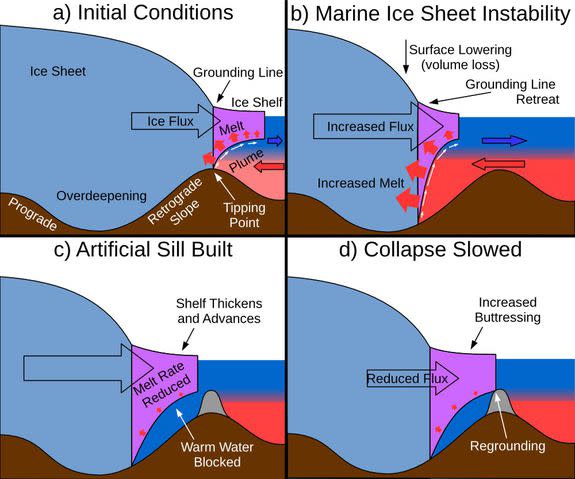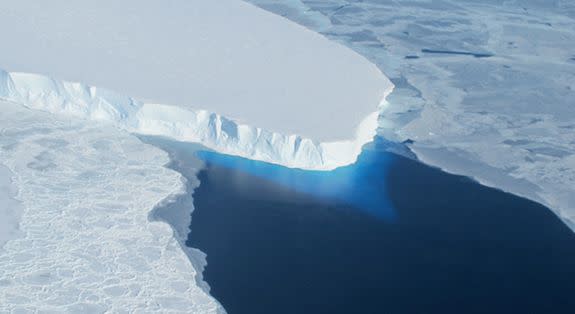If Earth’s great ice sheets start collapsing, massive undersea walls could hold them back

It would be best for humanity if the colossal ice sheets that blanket Antarctica stayed put. But, there's growing evidence that as the planet heats up, these sprawling glaciers could begin flowing into the ocean at an accelerated pace, boosting sea levels not in feet — but yards.
To halt the melting ice, some scientists have now proposed an ambitious geoengineering plan: constructing massive undersea walls to keep Antarctica's ice in place.
As Earth's temperature continues to rise due to human-caused global warming, it's still not well understood how quickly the ice sheets might collapse, but the melting of these glaciers is already underway.
SEE ALSO: The last 5 Augusts have been the hottest in recorded history
"The big goal would be to slow down or reverse an ice sheet collapse," Michael Wolovick, a Princeton University geoscientist and coauthor of the geoengineering study published Thursday in The Cryosphere, said in an interview.
A runaway, unstoppable flow of ice into the ocean isn't considered an immediate threat this decade or next, but very well could be by the century's end, or potentially sooner.

Image: nasa
"I don’t think that this sort of thing should be implemented anytime soon," said Wolovick. "But I’m of the opinion that we should care what happens to humanity beyond 2100."
A glacier of particular concern is the Thwaites, located in West Antarctica.
"If Thwaites were to collapse, it would take all of West Antarctica with it," said Wolovick, meaning an eventual sea level rise of 3 meters, or almost 10 feet.
Already, though, this glacier is melting at an accelerating pace.
"It's definitely retreating," Josh Willis, a NASA oceanographer who researches ice sheets and glaciers, said in an interview. "There's a lot of ice there, and a lot of potential sea level rise."
"The uncertainty is how fast is it going to go," Willis, who had no involvement in the study, added.

Image: nasa
The walls
Wolovick's study proposes two ideas, either of which would be massive infrastructure projects — some of largest ever attempted.
The researchers used the vulnerable Thwaites Glacier as their model and ran computer simulations to show how artificial structures might stop it from flowing unimpeded into the sea.
"The designs are simple," said Wolovick. "It's essentially just a big pile of dirt."
The first idea involves constructing isolated 300-meter (nearly 1,000-foot) high piles of gravel or aggregate beneath the portion of the glacier that floats over the ocean, known as an ice shelf.
The towering undersea mounds would catch the ice as it flows forward, allowing the ice sheet to "reground" on this artificial earth.
Naturally, the ice shelves — the front of the glacier that floats over the ocean — act as plugs. But if they collapse, there is no plug.

Image: Wolovick & Moore, The Cryosphere, 2018
So instead, these formidable mounds do the trick.
Just how much aggregate or "dirt" would this require? The researchers found that the project would need between 0.1 and 1.5 cubic kilometers.
For reference, when engineers excavated the Suez Canal in the 1860s — which was one of the largest civil engineering projects in history — they removed about 1 cubic kilometer of dirt, according to Wolovick.
For the second idea, the researchers proposed constructing a long, continuous wall, or sill, rather than building massive mounds. This option would likely have more success, said Wolovick, as the wall wouldn't just allow the glacier to "reground," but would also block relatively warm ocean waters from seeping under the glacier, and eating away at it from below.

Image: The National Snow and Ice data center
Warm water is a big threat. Over 90 percent of the accumulating heat on Earth gets absorbed by Earth's oceans. And these relatively warmer waters in the polar regions — while still frigid compared to temperate oceans — have already started thinning glaciers.
A smaller wall might block about 50 percent of these warm water currents, the researchers found. A larger wall would be even more effective.
And as time goes on, perhaps engineers will develop better ways to block the water, or build more advanced structures — rather than simply dropping masses of heavy dirt or aggregate on the seafloor.
"It might be possible to do something more intelligently," noted Wolovick.
It's not just expensive — it might not work
Geoengineering the planet — particularly the ocean — is widely acknowledged to be an immensely challenging undertaking.
"It’s hard, it’s expensive, and it might not work," said Willis.

Image: nasa
And if nations do ever decide to band together and dump masses of rock beneath collapsed Antarctic glaciers, the warming from above may still thaw the ice.
"Even if you build this wall to protect this ice from the ocean, it can still melt from the atmosphere," said Willis. "You can slow it down, but you’re not stopping it."
For this reason, Wolovick emphasizes that weaning ourselves off of heat-trapping greenhouse gasses is the critical solution, not glacial geoengineering.
"Glacial engineering is not a substitute for carbon emission reductions," he said.
Additionally, even if the giant walls worked — and the glaciers stopped in their tracks — it wouldn't stop heat waves, drought, and storms carrying considerably more water, Wolovick noted.
Climate change, emphasized Willis, is a global reality, which will require a global response.
"The scale of climate change is the whole planet," he said. "Trying to put these band-aids on is a precarious solution."
WATCH: Ever wonder how the universe might end?


